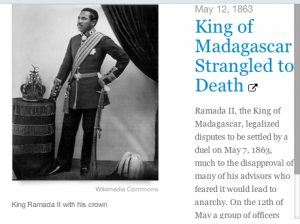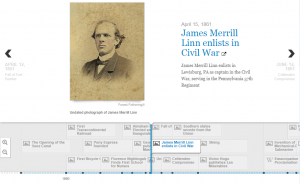Chronology of events is something that has always been crucial to the understanding of any sequence. Not only does to show us what the order of events was, it provides context. Throughout my time in school, history classes from elementary school to college have used timelines as a teaching tool. Although I have never put a lot of thought in to it, knowing the order of events is crucial to understanding. Grafton says that a timeline must be “possessing a structure” or show an “order of meaning,” (Grafton 11). For me, this is the same as the context that they provide for me. It isn’t completely about finding when they happened, but more about how they fit together in time and how they show a change or some trend. He says that in his article when he says, “the form of a timeline is….. emphazing overarching patterns and the big story,” (Grafton 20). It shows what happened in the time around an event, and knowing that can help you interpret each event differently, as well as the time.
Although i love timelines, I think some of the visuals on TimeMapper are tough to deal with and that the website could be switched around. It is hard to see all the events spread out, which would make it easier to jump to stronger connections. But, after analyzing our map and timeline, i did see a pattern. A vast majority of the events that we mapped were from two distinct categories. For me i see a broad spectrum of events, but most of them shows change and i want for voices to be heard.


On the below, you see the description of the murder of the King of Madagascar,, which is one of many change oriented events that were on our time mapper. Other events include the murder of the King, Unification of Italy, and the Civil War. These events show a desire for change in the way the world is, with the world in a time of progress. A common theme in this time was the desire for their words to be heard, whether its the publishing of a book, or a civil war about civil rights. It is a time for change, and i think our time mapper shows that.
 the time when Linn was writing his diary. The creation and study of our completed timeline made me realize a few things. For example, it’s very easy to get wrapped up in a particular set of events. As a result, it can be difficult to recognize, or pay significant mind to, larger events going on around the same time. When reading Linn’s diary, I found myself forgetting that he was writing about events in a small corner of the Civil War. Opening up the scale and comparing his story to the rest of history really put his story into perspective. The scale of a historical graphic really depends on how detailed you make it, represented well by the annals from the 700s in Grafton’s essay.
the time when Linn was writing his diary. The creation and study of our completed timeline made me realize a few things. For example, it’s very easy to get wrapped up in a particular set of events. As a result, it can be difficult to recognize, or pay significant mind to, larger events going on around the same time. When reading Linn’s diary, I found myself forgetting that he was writing about events in a small corner of the Civil War. Opening up the scale and comparing his story to the rest of history really put his story into perspective. The scale of a historical graphic really depends on how detailed you make it, represented well by the annals from the 700s in Grafton’s essay.